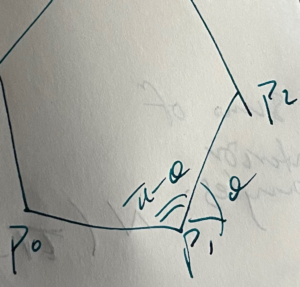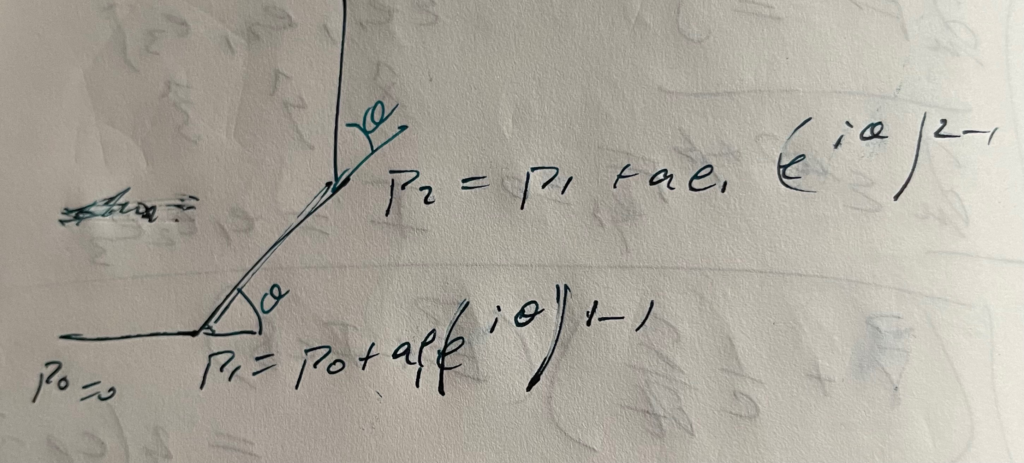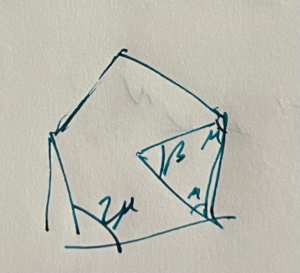[Click here for a PDF version of this post]
For reasons that I can’t explain, I woke up this morning dreaming about the interior angles of regular polygons. i.e. the angles \( \pi – \theta \), as illustrated in fig. 1.
The logical way to calculate that angle would be to slice the polygon up into triangles from the center, since each slice would have an interior angle would be \( 2 \pi / N \), and then the problem is just trigonometric. However, in my dream, I was going around the outside, each time rotating by a constant angle, until reaching the original starting point. This was a vector algebra problem, instead of a trigonometric problem, as illustrated in
fig. 2.
I didn’t have the computational power in my dream to solve the problem, and had to write it down when I woke up, to do so. The problem has the structure of a recurrence relation:
\begin{equation}\label{eqn:regularNgon:20}
\Bp_k = \Bp_{k-1} + a \Be_1 \lr{ e^{i\theta} }^{k-1},
\end{equation}
where
\begin{equation}\label{eqn:regularNgon:40}
\Bp_N = \Bp_0.
\end{equation}
We can write these out explicitly for the first few \( k \) to see the pattern
\begin{equation}\label{eqn:regularNgon:60}
\begin{aligned}
\Bp_2
&= \Bp_{1} + a \Be_1 \lr{ e^{i\theta} }^{2-1} \\
&= \Bp_{0} + a \Be_1 \lr{ e^{i\theta} }^{1-1} + a \Be_1 \lr{ e^{i\theta} }^{2-1} \\
&= \Bp_{0} + a \Be_1 \lr{ 1 + \lr{ e^{i\theta} }^{2-1} },
\end{aligned}
\end{equation}
or
\begin{equation}\label{eqn:regularNgon:80}
\Bp_k = \Bp_{0} + a \Be_1 \lr{ 1 + e^{i\theta} + \lr{ e^{i\theta} }^{2-1} + \cdots + \lr{ e^{i\theta} }^{k-1} },
\end{equation}
so the equation to solve (for \(\theta\)) is
\begin{equation}\label{eqn:regularNgon:100}
\Bp_N = \Bp_0 + a \Be_1 \lr{ 1 + \cdots + \lr{ e^{i\theta} }^{N-1} } = \Bp_0,
\end{equation}
or
\begin{equation}\label{eqn:regularNgon:120}
1 + \cdots + \lr{ e^{i\theta} }^{N-1} = 0.
\end{equation}
The LHS is a geometric series of the form
\begin{equation}\label{eqn:regularNgon:140}
S_N = 1 + \alpha + \cdots \alpha^{N-1}.
\end{equation}
Recall that the trick to solve this is noting that
\begin{equation}\label{eqn:regularNgon:160}
\alpha S_N = \alpha + \cdots \alpha^{N-1} + \alpha^N,
\end{equation}
so
\begin{equation}\label{eqn:regularNgon:180}
\alpha S_N – S_N = \alpha^N – 1,
\end{equation}
or
\begin{equation}\label{eqn:regularNgon:200}
S_N = \frac{\alpha^N – 1}{\alpha – 1}.
\end{equation}
For our polygon, we seek a zero numerator, that is
\begin{equation}\label{eqn:regularNgon:220}
e^{N i \theta} = 1,
\end{equation}
and the smallest \( \theta \) solution to this equation is
\begin{equation}\label{eqn:regularNgon:240}
N \theta = 2 \pi,
\end{equation}
or
\begin{equation}\label{eqn:regularNgon:260}
\theta = \frac{2 \pi}{N}.
\end{equation}
The interior angle is the complement of this, since we are going around the outside edge. That is
\begin{equation}\label{eqn:regularNgon:280}
\begin{aligned}
\pi – \theta &= \pi – \frac{2 \pi}{N} \\ &= \frac{ N – 2 }{N} \pi,
\end{aligned}
\end{equation}
and the sum of all the interior angles is
\begin{equation}\label{eqn:regularNgon:300}
N \lr{ \pi – \theta } = \lr{N – 2 } \pi.
\end{equation}
Plugging in some specific values, for \( N = 3, 4, 5, 6 \), we find that the interior angles are \( \pi/3, \pi/2, 3 \pi/5, 4 \pi/6 \), and the respective sums of these interior angles for the entire polygons are \( \pi, 2 \pi, 3 \pi, 4 \pi \).
Like, I said, this isn’t the simplest way to solve this problem. Instead, we could solve for \( 2 \mu \) with respect to interior triangle illustrated in
fig. 3, where
\begin{equation}\label{eqn:regularNgon:320}
2 \mu + \frac{ 2\pi}{N} = \pi,
\end{equation}
or
\begin{equation}\label{eqn:regularNgon:340}
2 \mu = \frac{N – 2}{N} \pi,
\end{equation}
as found the hard way. The hard way was kind of fun though.
The toughest problem to solve would be “why on earth was my brain pondering this in the early morning?” I didn’t even go to bed thinking about anything math or geometry related (we finished the night with the brain-dead activity of watching an episode of “Stranger things”.)


